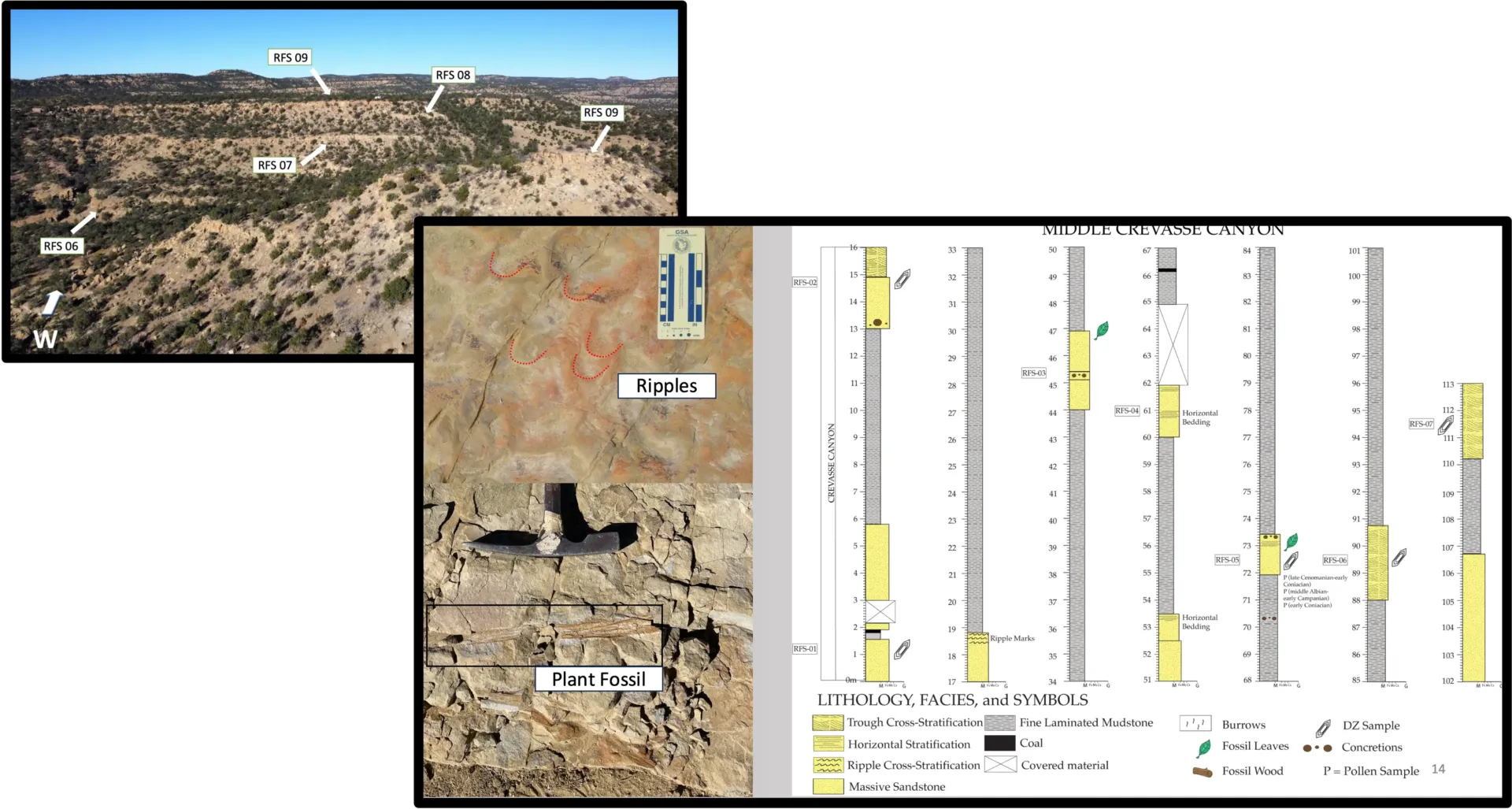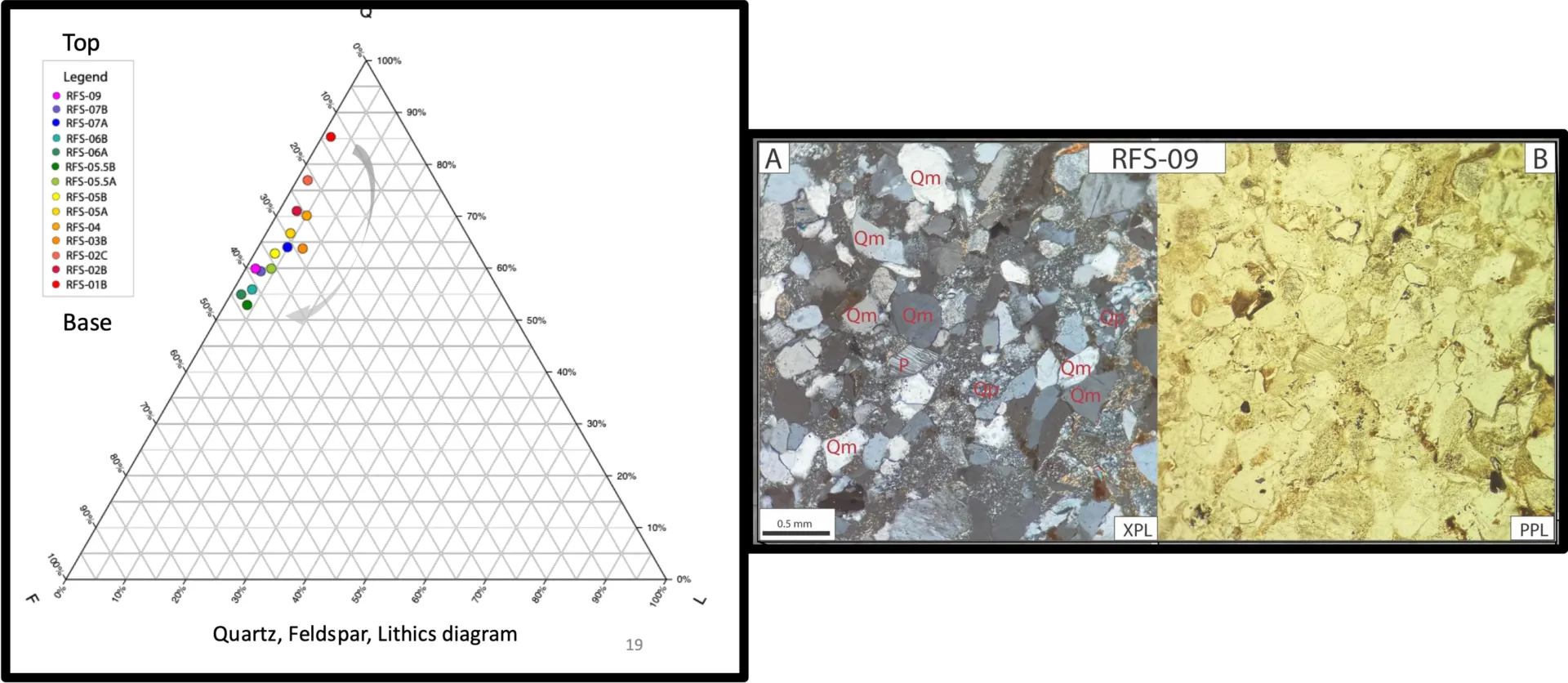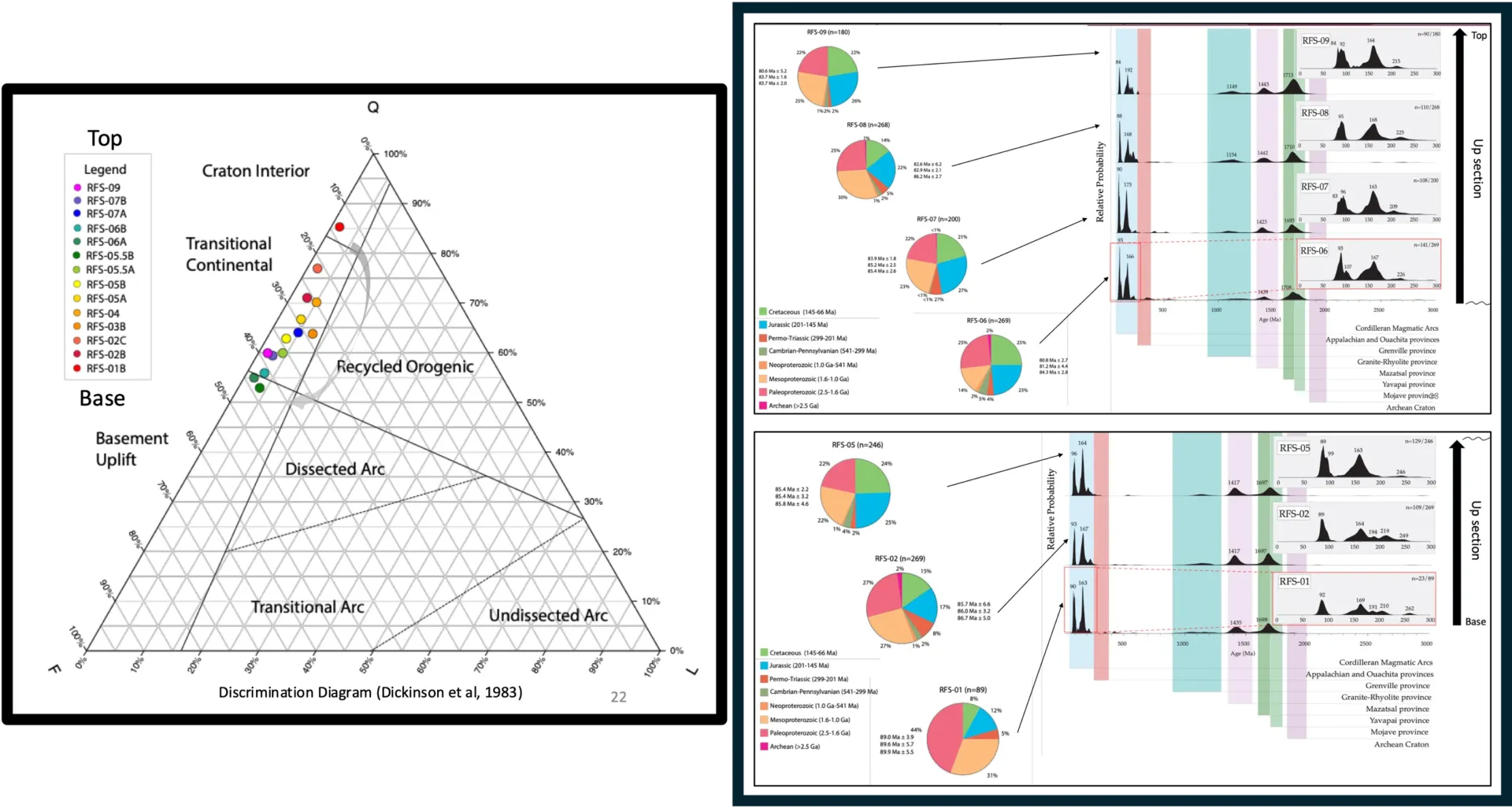Programs & Research
How We Operate
Professional research programs at Reynolds Field Station are conducted by professional staff scientists from museums, and research scientists, professors and graduate students from universities. The institutions have entered into Facility Use agreements with Reynolds Field Station that jointly establish the programs’ purposes and goals. Some programs are focused on original research, and others are oriented to developing educational curricula. Each program has a lead investigator who establishes technical and programmatic direction. The lead investigator and Field Station management identify strategic collaborators who can provide additional expertise and are invited to join the research efforts. In some cases, students and citizen scientists may be invited to participate or assist on programs, through postings in our Newsletter.
Currently there are four active programs, designated by the lead organizations:
- Perot Museum of Nature and Science Paleontology
- New Mexico State University Geology Field Camp Curriculum Development
- New Mexico State University Stratigraphic History and Provenance of the Crevasse Canyon Formation
- New Mexico State University Petrology & Mineralogy of the Crevasse Canyon Formation
We invite you to dive deeper into the work produced by professional scientists and students who have been engaged in research and learning at RFS, and those who have been instrumental in producing the curricula used for field science at RFS. You can peruse our programs’ research progress presented at professional meetings, poster sessions, and as theses on our Research Page.
We are continuously identifying and developing future programs two ways:
- The collaborative efforts of the active programs have identified future areas of related study [See Big Science Questions below].
- Ongoing exploration of the property has illuminated additional unrelated topics for new programs and research opportunities [See Upcoming Programs and Research Opportunities below].
We also anticipate that some visiting professionals will wish to join existing programs or have new research areas they wish to pursue. We welcome proposals through the Contact Us options.
Multi-Institutional Research
NOTE TO READERS OF THE FOLLOWING SECTIONS:
The program descriptions below contain technical words and terms with which non-professionals may not be familiar. To make them accessible to a wide audience, we will be providing a dynamic hover feature for technical words in the near future. The following is a link to the Glossary and Educational Material on the Education and Outreach page, where many terms are explained.
Interactive Glossary of Terms in the Context of Reynolds Field Station
Program: Perot Museum of Nature and Science Paleontology (PMNS001)
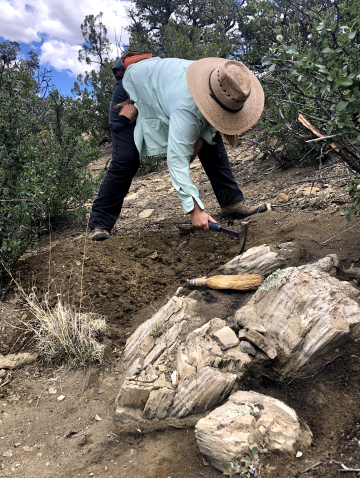
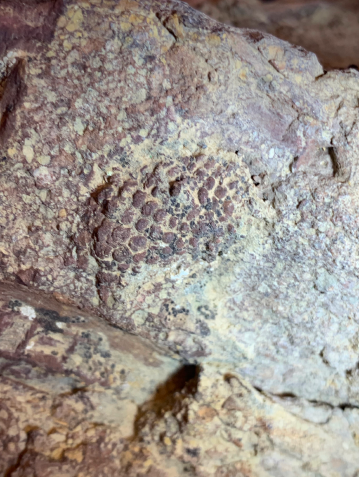

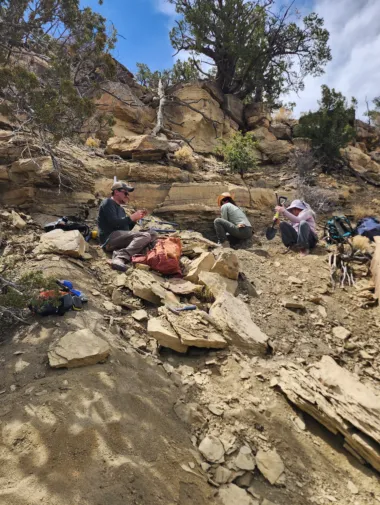
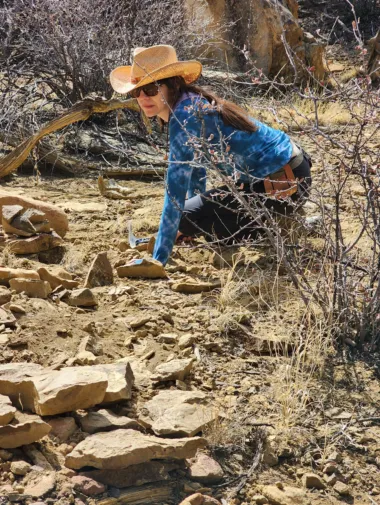
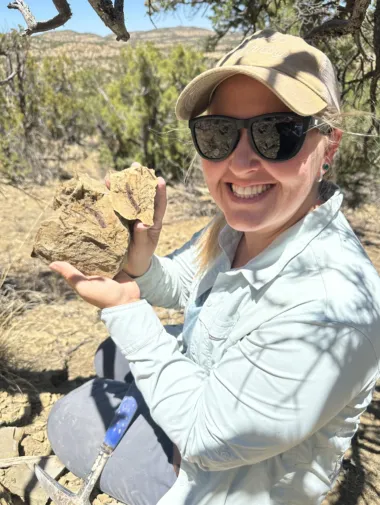
Purpose
The PMNS Paleontology program on the Reynolds Field Station and surrounding BLM lands aims to understand the terrestrial vegetation and fauna of the Western Interior during the Turonian-Coniacian stages of geological time. These stages capture a critical interval of change in western North American terrestrial ecosystems as flowering plants underwent an explosive increase in their number of species and their ecologies, spreading across the globe and displacing gymnosperms and ferns in many environments. The resulting turnover in the composition of terrestrial vegetation set the stage for the emergence of modern ecosystems. The time interval preserved in rocks exposed on the Reynolds Field Station and surrounding lands is one in which we have very few records of the ancient plant-life in North America. Any and all paleobotanical records from this time represent important contributions to the scientific record that enable us to better understand patterns of ecosystem changes across the continent. Furthermore, the terrestrial vertebrate fossil record of this time and place is woe-fully underrepresented compared to the rich record later in the Cretaceous; therefore, corresponding prospecting for vertebrate fossils is an ongoing aim of the program.
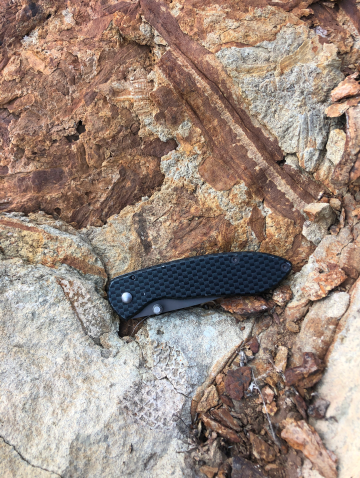
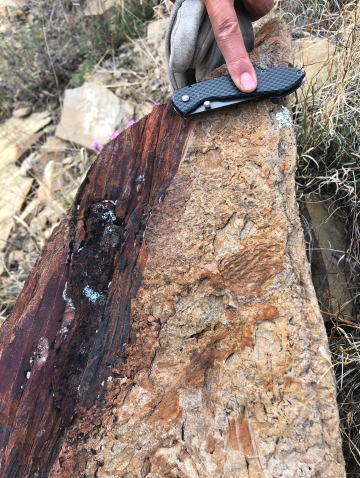
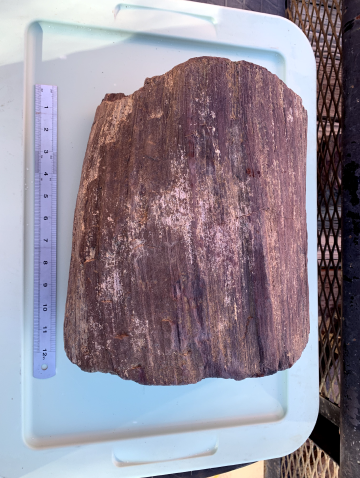
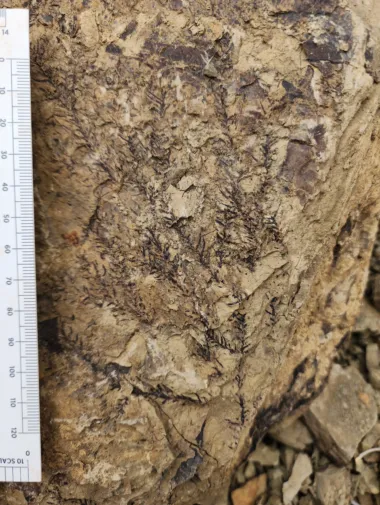


Description
The PMNS paleontology program, under direction of Dr. Dori Contreras and Dr. Ron Tykoski, is taking a multifaceted approach to reconstructing ancient ecosystems from fossil flora and fauna. The regional vegetation is being reconstructed based on plant fossils collected from multiple facies and stratigraphic layers, including the study of fossil leaves, reproductive structures, pollen, spores and woods. The integrated study of these various types of plant fossils and associated geological settings is important for building a wholistic view of vegetation across heterogeneous paleo-landscapes. Together with the fossilized remains of animals and trace fossils, these reconstructions enable an understanding of the habitats of terrestrial animals at that time and ecosystem functioning. PMNS research staff are working with students, museum volunteers, and other professional researchers to complete these studies.
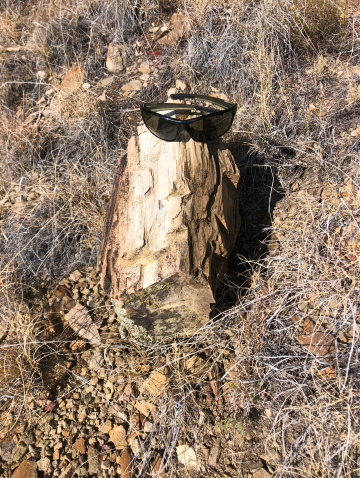

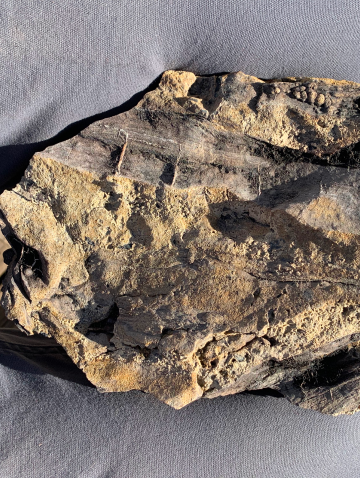
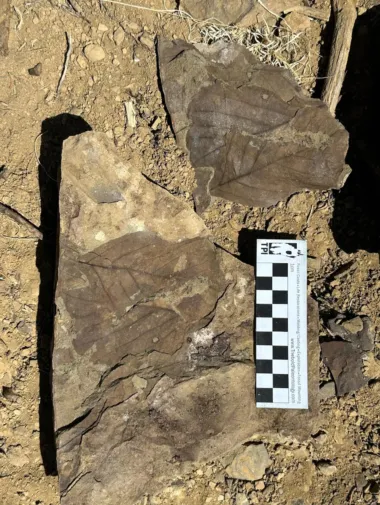
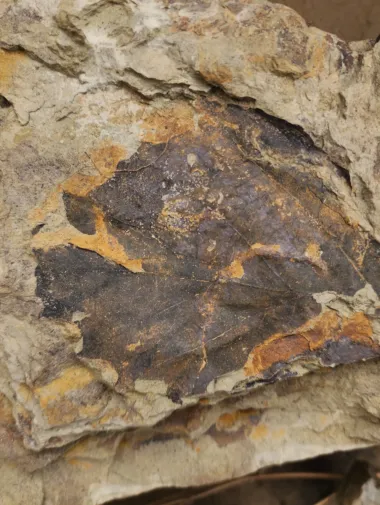
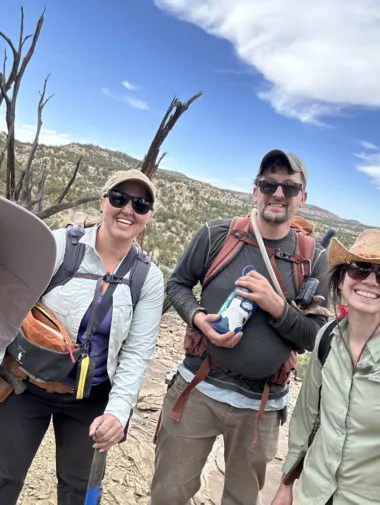
Anticipated Outcomes
The PMNS research program will produce scientific publications that will help reconstruct the ancient plant communities and ecosystems of the region, through description of the fossil plants documented at the RFS and surrounding area. Results will also be presented at professional conferences, as well as to the general public through various venues and societies. Media and public outreach will accompany publication of scientific findings to ensure broader dissemination, accessibility, and impact of the research findings.
Specimens collected on the RFS property, and on BLM land with valid permit, will be accessioned in the collections of the Perot Museum of Nature and Science. Specimens will be professionally prepared and curated following best practices and held in public trust in perpetuity, thereby guaranteeing their preservation and accessibility for future research and education in perpetuity.
Progress
Thus far, multiple productive plant fossil sites spanning the research station have been identified and excavations are ongoing. These have revealed a diversity of foliage, reproductive material (flowers, cones, fruits and seeds), and woods. Collected specimens are currently under study. Palynological samples from multiple stratigraphic horizons have yielded well-preserved pollen that is adding to the taxonomic diversity and environmental and age interpretations, in conjunction with the ongoing stratigraphic framework being developed by the NMSU program. Ongoing prospecting for terrestrial vertebrate fossils is promising. Enjoy the great pictures and story of the May 2025 Fossil Dig and Exploration Season on our News Blog.
University Research Programs
New Mexico State University Geology Field Camp Curriculum Development (NMSU001)
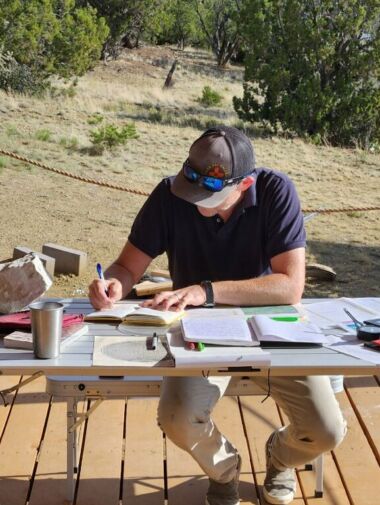
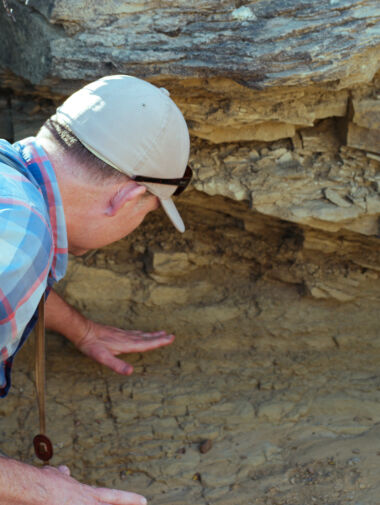
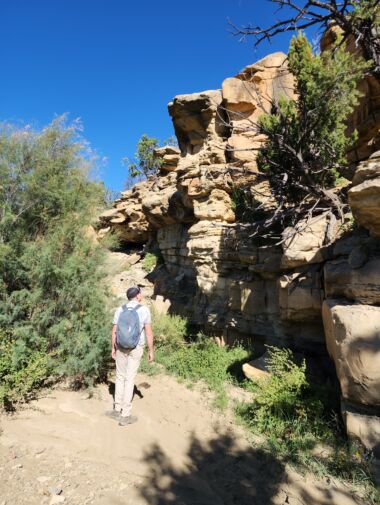
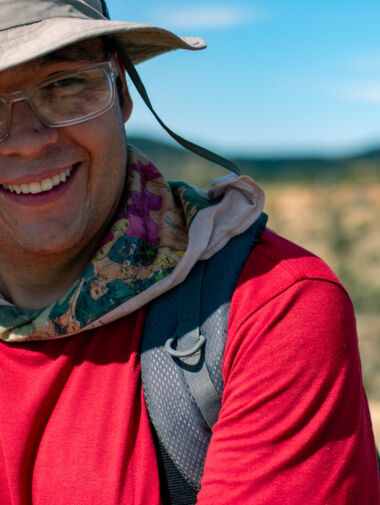

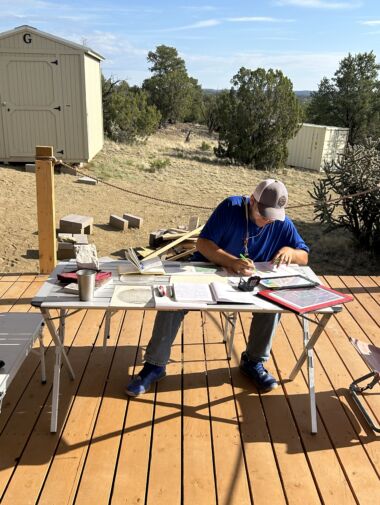
Purpose
NMSU’s Department of Geological Sciences teaches their summer field camp capstone courses headquartered at the Reynolds Field Station. In Program NMSU001, the Reynold’s Field Station (RFS) joined in collaboration with NMSU’s Department of Geological Sciences in 2023 to develop a place-based, capstone, field-mapping experience for upper-division, students as part of the field-camp requirement for the Geosciences Degree at NMSU. All field-based projects for this course take place at the RFS and at key/classic field localities within a 100 mile radius (e.g., Sawtooth Mountains, Quebradas Backcountry, Lemitar Mountains, and Malpaís volcanic field)
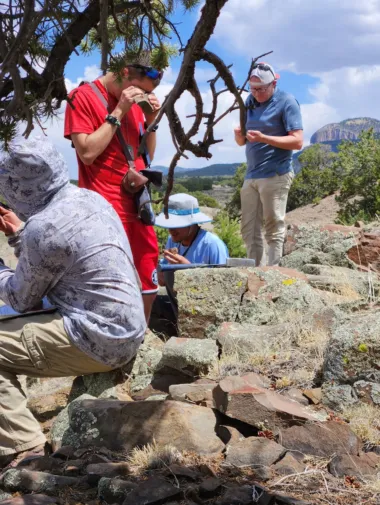
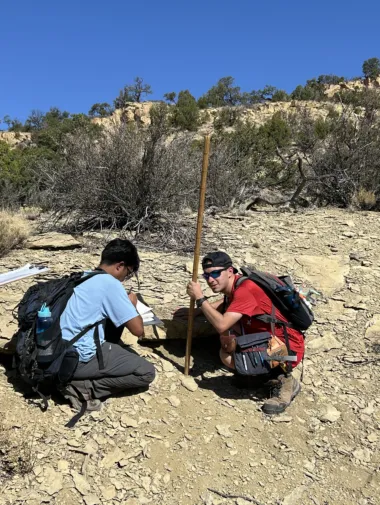
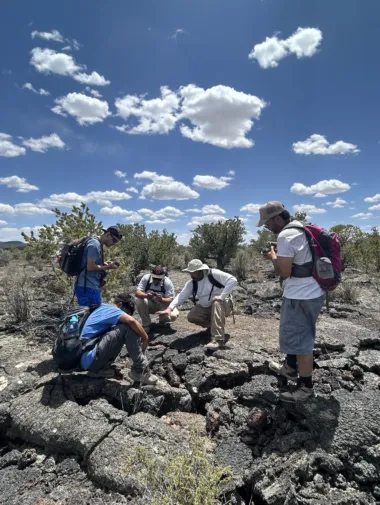
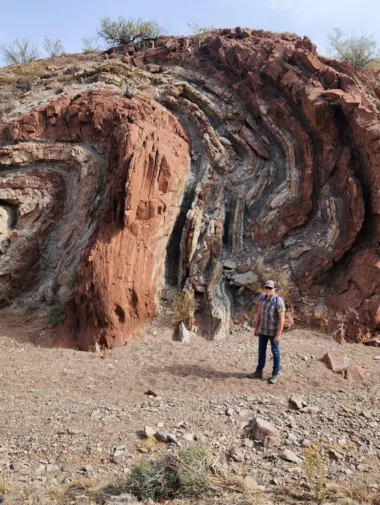
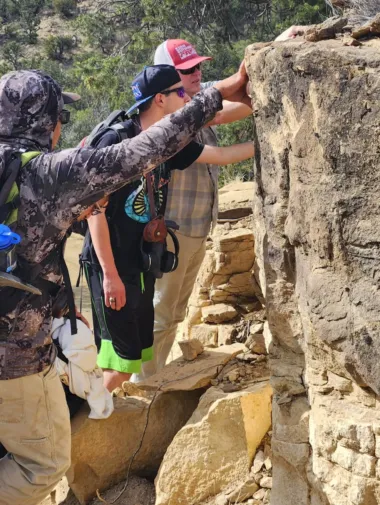

Description
As part of Program NMSU001, Dr. Brian Hampton and graduate student, Thomas Valenzuela spent time in spring/summer, 2024, putting together a 3-week field curriculum that includes field-based exercises at the RFS (e.g., measured stratigraphic sections, Cretaceous sedimentary facies mapping, and provenance/paleocurrent determinations). In addition to projects at the RFS, students also travel to nearby satellite field-mapping areas that include Laramide fault-bend folds (in Penn-Permian stratigraphy), Rio Grande Rift normal (domino) faulting, and Oligo-Miocene syn-rift strata and volcanics, and mapping of young Holocene volcanic flows in west-central New Mexico. In addition to standard field mapping, cross-sections, and measured stratigraphic sections, student participate in detailed field sketching and detailed lithologic description of much of New Mexico’s Phanerozoic stratigraphy.
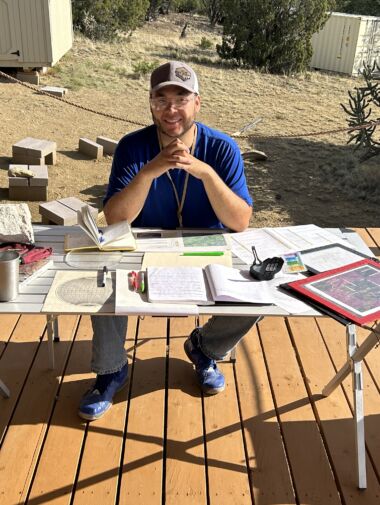
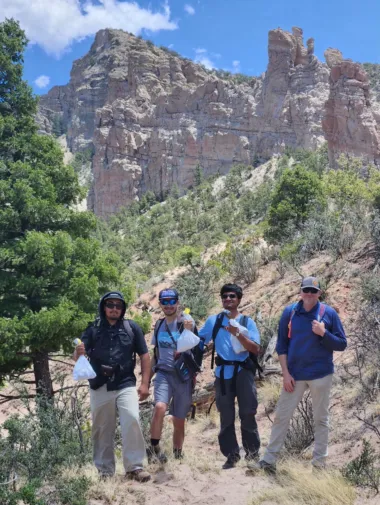
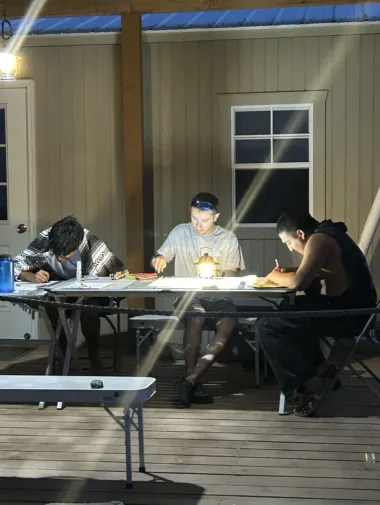


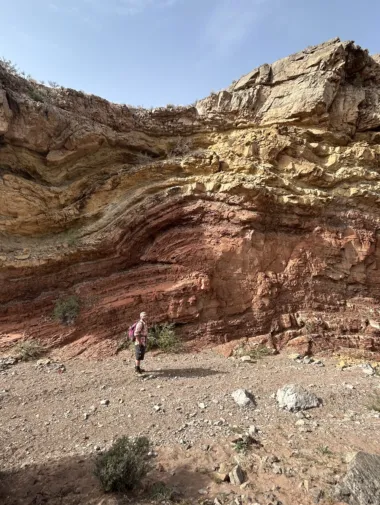
Anticipated Results and Progress
This program successfully developed a curriculum for the capstone field course, and RFS hosted the first class in May and June 2025.
Here is a summary of some of the field projects and themes in the field course in 2025:
- Rio Grande Rift (RGR) normal faulting: Examples from the Ward Tank and East Robledo fault (west of Las Cruces, NM) – Deliverables: Field notes and descriptions
- Post Laramide/Pre-RGR ignimbrite flare-up volcanic and volcaniclastic rocks at Point-of-Rocks (north of Las Cruces) – Deliverables: Geologic map and cross-section
- Upper Cretaceous strata of the Crevasse Canyon Formation at the Reynolds Field Station (RFS) – Deliverables: Outcrop sketch and measured stratigraphic section
- Stratigraphy and petrology of Eocene-Oligocene volcanic rocks of the Sawtooth Mountains and Mogollon Rim (near Datil, New Mexico) with Dr. Jennifer Thines – Deliverables: Detailed lithologic/petrologic descriptions and summary report
- Complex Laramide fault-bend-folds in Penn-Permian stratigraphy in the Quebradas Backcountry (just east of Socorro; off-RFS camping) – Deliverables: Geologic map, north/central/south cross-sections, and outcrop sketch
- Complex Rio Grande Rift structure (domino faults and relay ramp) and Miocene-Pliocene synorogenic rift fill and volcanic rocks in the Lemitar Mountains (north of Socorro; off- RFS camping) – Deliverables: Geologic map, cross-section, and outcrop sketch
- Sea-level variations in Upper Cretaceous strata at the RFS (top Gallup Sandstone/base Crevasse Canyon Formation) – Deliverables: Measured stratigraphic section across the Gallup-Crevasse Canyon contact
- Paleocurrent measurements (and flow determination) from Upper Cretaceous strata at the RFS (Crevasse Canyon Formation) – Deliverables: Summary report including stereonet determinations
- Stratigraphy and provenance of the Paleocene Baca Formation (in the Sawtooth Mountains south of the RFS) – Deliverables: Measured stratigraphic section and summary report of clast compositions
- Finally, half day return to NMSU in Las Cruces, NM to complete all project write ups!
This diverse set of field mapping experiences is made possible by the extremely varied geology and tectonics of New Mexico, and the close proximity (at most a few hours) from RFS, and has the added benefit of a very low cost Field Camp. NMSU’s investment in curriculum development last year has yielded a one-of-a-kind experience for Capstone Field Camp students. Contact Dr. Brian Hampton directly or indirectly through our Contact Us page for information on participating in this Wild West Geology adventure.
We are also so proud to announce that just prior to Field Camp, our extremely able Teaching Assistant, Thomas Valenzuela successfully defended his Master’s Thesis. You can read his thesis on his thesis research page.
The curriculum format is flexible and designed to be adaptable to new field areas, class size and technological student skills.
New Mexico State University Stratigraphic History and Provenance of the Crevasse Canyon Formation (NMSU002)
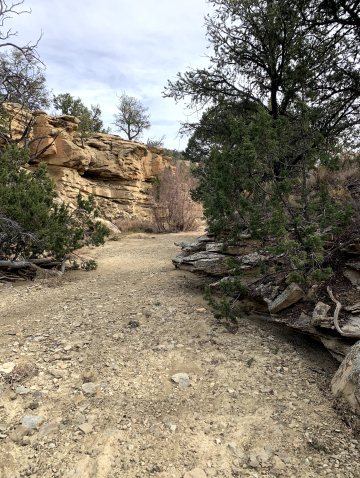
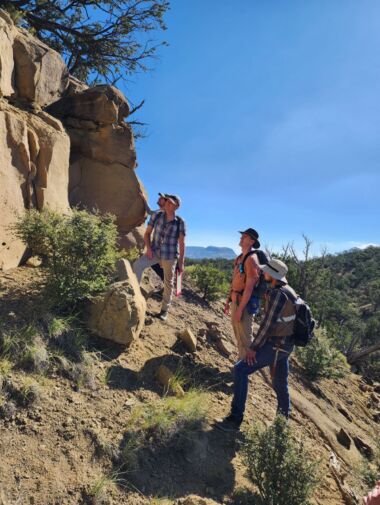
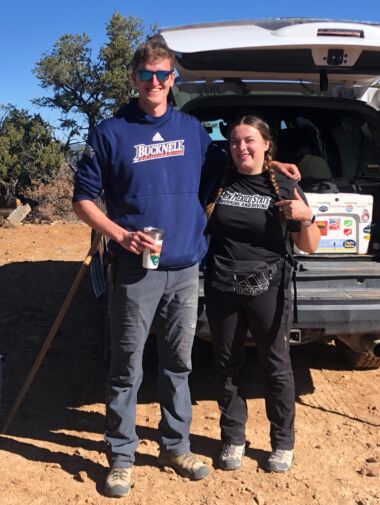
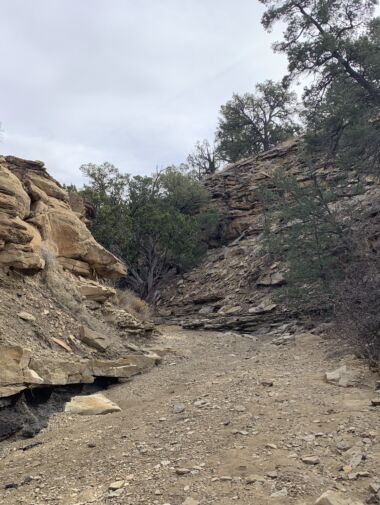
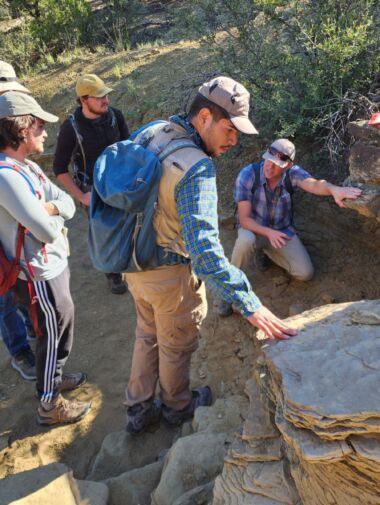
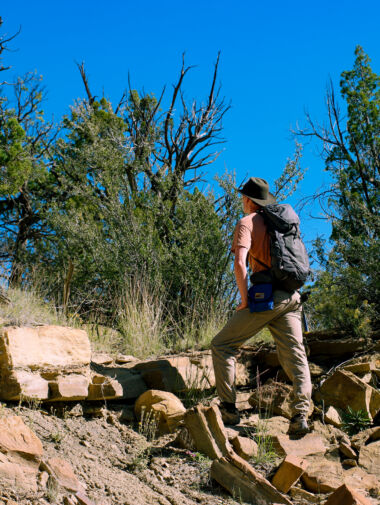
Purpose
NMSU Geology Master’s students will map the Crevasse Canyon Formation on the Reynolds Field Station and surrounding Bureau of Land Management (BLM) lands to understand the distribution of and changes in facies, and develop the stratigraphic history and provenance of the formation, including changes in provenance over time. Detrital zircon U-Pb age determinations, depositional environment analysis, and sandstone petrology will put the stratigraphic framework into an absolute geochronologic framework, allowing correlations with units of similar age throughout the Cretaceous Western Interior Seaway. The students will incorporate cross-disciplinary information from the ongoing paleontology research in RFS Program PMNS001, adding independent depositional environment data synthesized into a unified, holistic interpretation.
Description
The first series of M.S. research projects at the RFS began in 2023 and have been focused on the lower Crevasse Canyon Formation with emphasis on the following:
(1) Initial drone mapping of key thick/resistant sandstone bodies
(2) Making detailed measured stratigraphic sections
(3) Determining paleoflow from key paleocurrent indicators
(4) Constraining detrital modal composition (from sandstone point counts)
(5) U-Pb detrital zircon geochronology (for provenance and Minimum Depositional Age determinations).
This first stage of the project was carried out by NMSU graduate student, Leo Kuyl under the direction of Dr. Brian Hampton during 2024-2025.
Progress and Anticipated Results
Leo’s project was completed in four semesters (two years) and resulted in the following:
- New maps that helped place key Cretaceous sand bodies in a stratigraphic context for current and future researchers
- New, detailed measured stratigraphic sections (and interpretation on Santonian depositional system)
- New modal composition data from N=14 sandstone samples/n=5600 counts
- New preliminary paleoflow data from n=400+ measurements
- New U-Pb detrital zircon ages from N=7 samples/n=1514 (new U-Pb ages)
Results from this project have been presented at the 2025 New Mexico Geological Society, Spring Meeting, as well as the 2025 GSA Annual Meeting and are being prepared for publication. Leo recently defended the results of his thesis in early October, 2025 (see his thesis defense slides here), and has accepted full-time employment as a geologist at ExxonMobil that will start in December, 2025. Leo worked in collaboration with the University of Arizona LaserChron Center to analyze all detrital zircons. All field work and thin section prep was supported by the RFS and NMSU.
Future Graduate students and researchers will build on and expand the mapping through the upper Crevasse Canyon formation, increasing the measurements of paleoflow, depositional environment indicators and expanding the U-Pb detrital zircon sample set. Further work on the characterization of the sandstones will integrate research results from both Programs PMNS001 Paleontology and NMSU003 Petrography and Mineralogy.
New Mexico State University Petrography & Mineralogy of the Crevasse Canyon Formation (NMSU003)

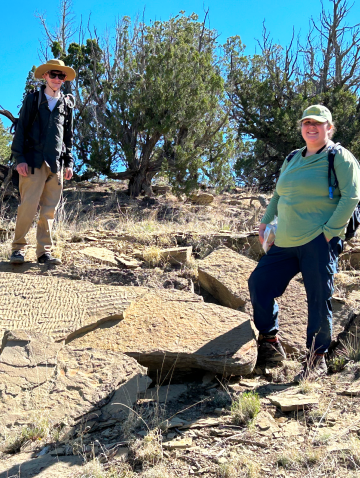
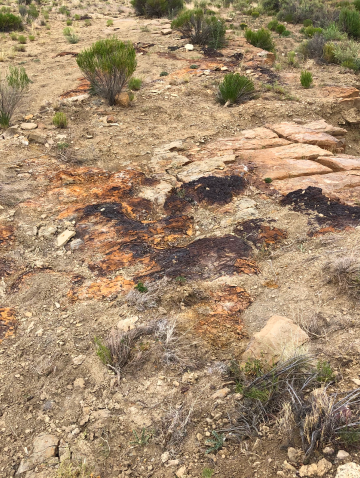
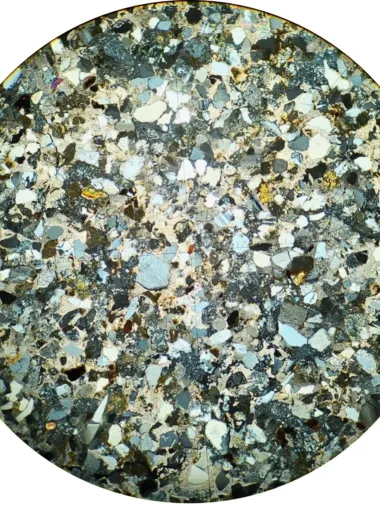
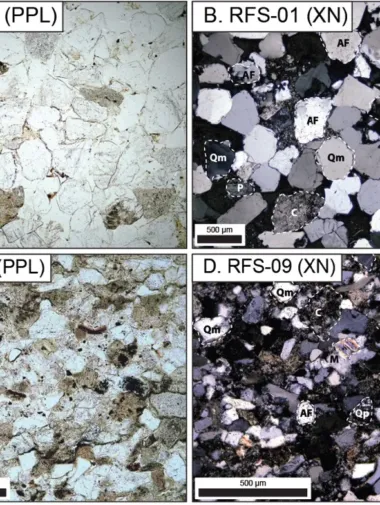

Purpose
NMSU Masters students will investigate the mineralogy and petrography of the Crevasse Canyon Formation to understand sediment provenance and changes during and after diagenesis (changes to sediment as it becomes a sedimentary rock). The Crevasse Canyon consists of interlayered non-marine sandstones, mudstones (fine-grained, non-laminated sedimentary rocks), and paleosols (fossil soils). Research is two pronged: what can the mineralogy of the sandstones telling us about sediment source and the basin history? What can the finer mudstones tell us about the pore fluid composition during rock formation and later chemical processes?
(1) This study will integrate petrographic and heavy mineral analysis with detrital zircon and K-feldspar geochronology of the sandstones to constrain the provenance of Crevasse Canyon Formation sediments and evaluate how these different proxies capture distinct aspects of the depositional and basin histories. Due to differences in resistance in weathering, zircons tend to more reliably capture the signature of older, recycled sources while feldspars capture younger inputs. Heavy mineral assemblages can be powerful indicators of variations in source lithologies, especially when combined with conventional petrographical and detrital geochronologic studies. Together, these three datasets have the potential resolution power to differentiate sources by age and lithology.
(2) The mudstones have variable amounts of calcite (calcium carbonate; CaCO3) and siderite (iron carbonate; FeCO3) that precipitated between grains to form a cement (“glue”) or iron-rich concretions. Interestingly, siderite forms in reduced iron-rich environments while calcite more commonly forms in oxidized conditions. Research is focused on evaluating the relationship between calcite and siderite in these rocks, the role of post-diagenetic fluid flow, and relationship between this carbonate precipitation, interlayered coals, and microbial activity.
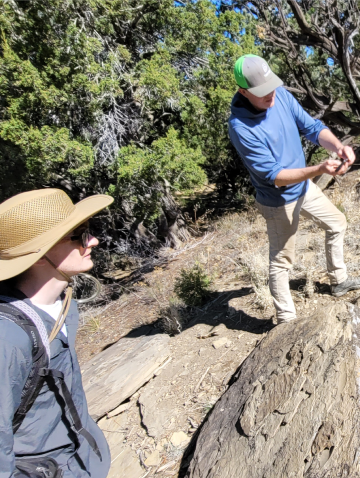
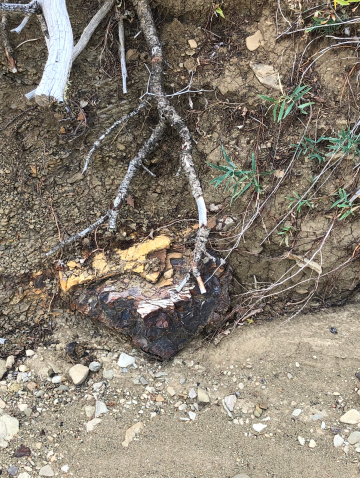

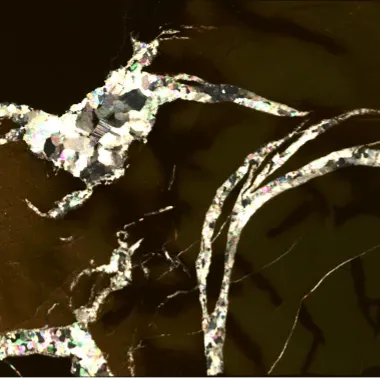

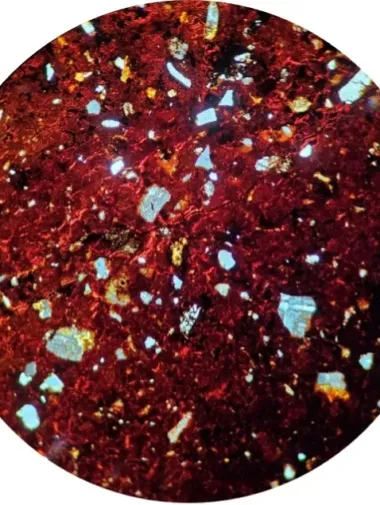
Description
With the mentorship of Dr. Jennifer Thines, and in collaboration with the NMSU Masters students advised by Dr. Brian Hampton, graduate students will perform detailed petrographic analyses of the sandstones and mudstones using optical microscopy, heavy mineral analysis of separated grains, mineral chemistry analyses using the electron microprobe, and radiogenic isotope analysis of the carbonate minerals. Together, these data will be used to determine (a) the provenance signature (i.e., mineralogy, clast lithology) of the Crevasse Canyon Formation as recorded by the entire mineral assemblage, and (b) post-depositional changes to mineralogy, porosity, and permeability.
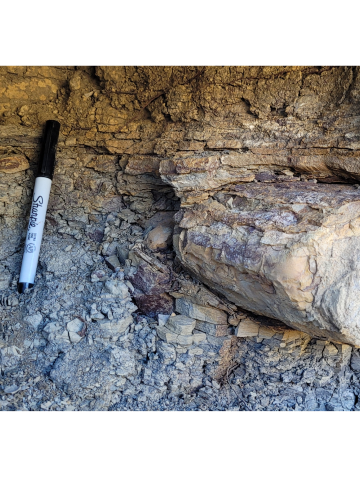
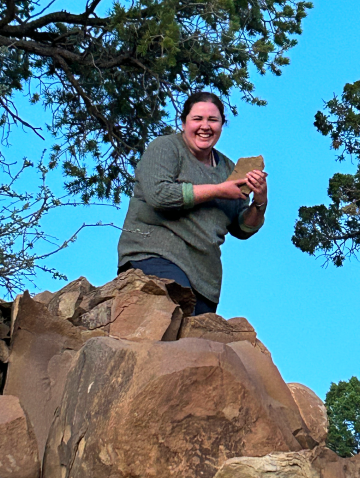
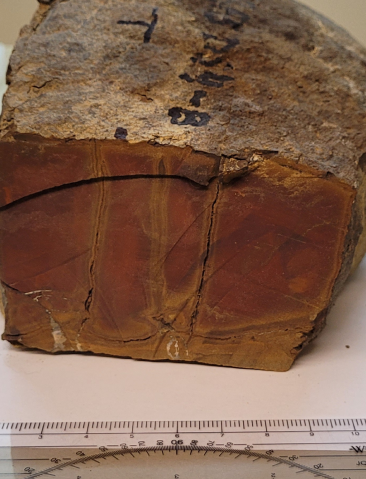
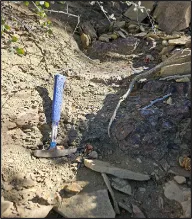
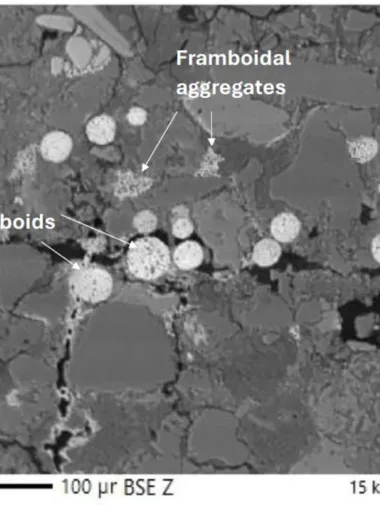
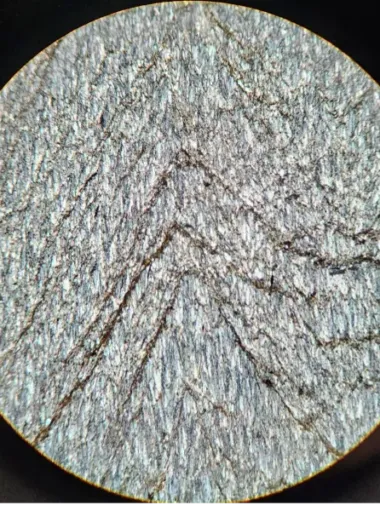
Anticipated Results or Products
MS theses; sample set with thin sections of the siderite- and Fe- bearing rocks, textural analysis; EMPA analyses; whole rock analyses; at least one presentation at a conference; at least one published paper.
Progress
Master’s student Shane Deacon has presented a talk titled “Investigation of siderite precipitation in the Crevasse Canyon Formation in westcentral New Mexico” on his research progress at the New Mexico Geological Society Spring Meeting. You can read his presentation here.
Big Science Questions
In 2023, the focus of science and exploration was dominated by the abundance of Cretaceous geologic and paleontological discoveries that we were constantly tripping over on the property. Discussions in the field among the interdisciplinary teams about their preliminary observations stimulated bigger questions and conversations of tectonic and paleoclimatic scope, and global scale.
The pursuit of those bigger questions will benefit from the expanded participation of additional disciplines, such as geochemistry, paleoecology, micropaleontology and others. Collaborations and correlations with other researchers working on same age deposits in other areas in New Mexico and in states along the Cretaceous Western Interior Seaway will also enhance large-scale regional understanding. The Cretaceous exposures at the Reynolds Field Station have not been studied in depth prior to the current NMSU and PMNS programs. We expect integrative collaborations will bring additional perspectives and data that contribute to regionally coherent, tectonic-scale advances in
understanding.
The research teams have been collecting their hypotheses (theories), unanswered questions and anomalous (unexpected) findings into a dynamic list they have dubbed Big Science Questions at Reynolds Field Station. The list (BSQ for short) will be continuously refreshed with updated data and analyses, and will guide current and future research programs.
RUNNING LIST OF BIG SCIENCE QUESTIONS
Upcoming Programs and Research Opportunities
Field exploration and new discoveries in 2023 illuminated additional unrelated topics that beg for attention as the focus of new near term programs. We have developed conceptual descriptions for three upcoming programs in Neoglacial Reconstruction, Ecology and Astronomy. We are currently pursuing new partnerships and collaborations with researchers and institutions for these programs. Contact Us if you have an interest in leading or participating in an upcoming program, or for more information.
Neoglacial Environment Reconstruction Program
Extraordinary, ancient cultural artifact discoveries at RFS indicate Indigenous inhabitation of the property during Paleo to Archaic Cultures / Early Holocene to Neoglacial periods.
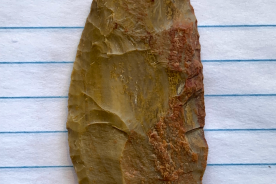


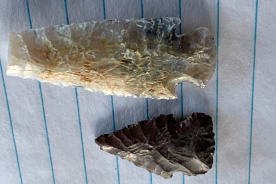
We propose a Neoglacial Environment Exploration program in the valley and surrounding area where Paleo and Archaic Culture artifacts are found. It is a unique program in which we aim to integrate Indigenous students into multi-disciplinary science research programs exploring glacial and neo-glacial biology, climatology, geomorphological reconstruction, palynology, archaeology and culture. The Valley of the Ancient Hunters at Reynolds Field Station offers an opportunity to apply scientific tools in a multi- faceted reconstruction of the land, plants, animals and people who were present during Neoglacial times. We envision exploration that is intentionally and respectfully designed to be culturally relevant for Indigenous learners. We are committed to working with our Indigenous partners to craft an integrated approach in developing this program.
Primeval Piñon-Juniper Highland Ecology Program
Our pristine 1000-year old primeval forest at 7700’ elevation, with its diverse ecology and biological populations has never been harvested, mapped or researched.
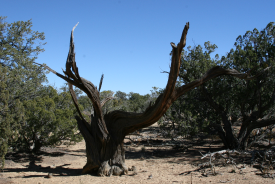
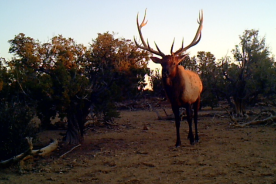
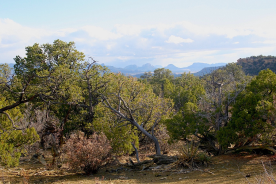
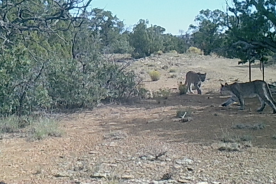
We propose a collaborative field exploration program that brings together a present-day (“extant”) ecological constellation of biology, botany, entomology, soil science, geomorphology and climatology to study this ancient high altitude alpine forest, where deadfall logs have yielded tree ring counts greater than 700 (piñon) and 1000 (juniper) years. The isolation of this environment has allowed wildlife populations to flourish, with an intact and healthy life chain from apex predators to as yet unstudied
keystone species. This program offers broad educational avenues for students and citizen scientists to participate in tree ring studies, species surveys, and descriptive (and artistic!) botany. It is an opportunity to conduct long-term analyses of droughts, water conservation, wildlife studies, and the interaction of the fauna, flora and entomology with the environment, as examples. There is a possibility trees this ancient may have recorded exceptional solar coronal mass ejection events, a potential integration of botany with historical astronomy. We feel an extant-focused program will be a great complement to the paleo-focused programs already under way, and we are currently looking to identify institutions that are interested in engaging in our unique field lab
Update: We are in the initial stages of developing a program to monitor and study the RFS forests with the University of Nevada Las Vegas. Stay tuned for the official creation of a Piñon-Juniper forest drought resilience study.
Deep Time in Astronomy and Geology: A Dark Sky Exploration Program
An unparalleled dark sky, where no man-made light diminishes the astronomical viewing conditions, provides mind-expanding experiences for all constituents.
We propose integrating observational astronomy into the learning experiences of students and visitors. Our Board member, Mark Leonard, is a degreed astrophysicist who leads our astronomy program development. Our program is a guided tour of the night sky, starting with familiarizing aspects of the moon, solar system planets, the Milky Way, and constellations. Astronomical viewing equipment at the Reynolds Field Station will provide a deeper look at astronomical objects, some of which are not visible to the naked eye. The program introduces concepts of the astronomical distance in light years to specific objects seen through a telescope. Observations of telescopic objects step progressively farther back in time to the same moments in geological deep time, when the rocks at the Field Station were being deposited. In the future, we will also seek opportunities to integrate scientific astronomical observations with Indigenous Ways of Knowing the night sky
Update: We are pleased to announce that Mark Leonard has donated a 10″ Dobsonian Telescope to RFS, and we are preparing to also add a SeeStar S50 to our astronomical viewing equipment to give students a multi-science appreciation of the land and sky above them. Stay tuned for announcements of our first tour of our spectacular night sky!
Digital “Big Field Data” (aka BFD) Multivariate Geology Synthesis
&
AI Analytics: Large Quantitative Model (LQM)
The many researchers exploring RFS have been collecting an ever-growing multi-disciplinary digital, geo-located data set.
As we push forward in digital data acquisition technologies at RFS, integrating more drone mapping and correlation, digital elevation maps, precise geo-located geologic measurements and cloud-based data repositories, we will be growing a large and diverse “big data cube” of field data, alternatively “digital big field data” or Digital BFD. At the same time, the many field mappers and explorers are collecting an increasing number of paleontological and geological rock paleontological samples that are undergoing sophisticated analytical techniques at high tech laboratories such as the LaserChron Center. These “hard data” points may range from the microscopic to outcrop scales, but they will all be geo-located.
We are committed to pushing the envelope of the synthesis of all this multi-faceted field data and big data analytical techniques in large quantitative models (LQM’s) to posit new theories of correlations and anti-correlations that can be ground-truthed with field verification (or invalidated with field inspection!). This is a new field that allows us to explore new ways of synthesizing conclusions from multivariate field sampling, and is well-aligned with our multi-disciplinary exploration mission. At a minimum, it will open the door to new ways of visualizing geology in 3-D to help students grasp the geological context beyond the surface outcrops.
We are seeking partners in big data analytics to join us in this paradigm-shifting approach.
Have an Idea for a Future Program?
We welcome suggestions and proposals for future programs at the field station. We are happy to discuss potential research, teaching and educational projects that align with our vision and mission!

INTERESTED IN LEARNING MORE?
Explore With Us!
We are passionate about the sharing the amazing environment and scientific learning opportunities at the Reynolds Field Station. We encourage you to Contact Us about ways you and your institution can participate in exploring and contributing to the science and appreciation of this natural wonderland. We are a 501(c)(3) public charity and welcome donations that will enable travel expenses, grants and scientific equipment for learners who need assistance participating at the Field Station.

